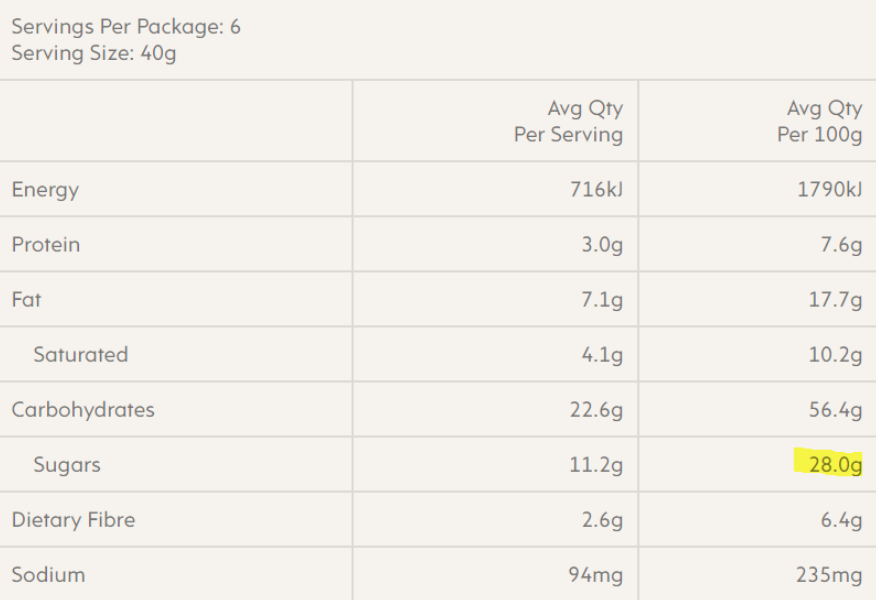
Many people are looking to cut their sugar consumption. And for good reason – it’s calorie dense and low in nutritional value, and excessive sugar in the diet can lead to obesity and weight gain, which increase the risk of heart disease, type II diabetes, and cancer.
Sugary snacks and drinks have also been linked to rising tooth decay in children. What might be surprising is the number of foods and supplements we consume daily that contain hidden added sugars.
Sugars – starting with the basics
Sugars belong to the carbohydrate family in nutrition. Carbohydrates are defined as Simple or Complex. Simple carbohydrates made of building blocks called monosaccharides like glucose, fructose, and galactose, which are single chain sugars, and disaccharides which are two chains joined together – maltose, lactose, and sucrose. Complex carbohydrates are made up with many chains of sugars and are known as polysaccharides. You might have heard of these as starch, fibres, or glycogen.
Carbohydrates are found in many foods like grains, fruits, vegetables, and nuts. Carbohydrates provide a lot of great vitamins and minerals within a diet, as well as being a source of fuel. Many of these wholefood-based forms of carbohydrates contain complex carbohydrates. When foods are processed, they tend to be richer sources of simple carbohydrates, examples are sugar, fruit juice, processed bleached flours, etc.
Complex carbohydrates contain starches and fibre which are undigestible by the body, and their many chains of sugars take longer to breakdown into glucose during digestion. Both of these factors mean that complex carbohydrates are usually more friendly to blood sugar levels and the body than simple sugars, which are easily broken down into glucose.
Are all sugars created equal?
Simple sugars (particularly fructose and glucose) are usually added to foods and over time with over-consumption are problematic for the body. Because these have been stripped from their natural source, they lose the beneficial nutrients that accompany them in nature. In this context they are referred to as free or added sugar. Free sugars are in many packaged foods and often places you don’t expect it, like barbeque sauce, salad dressings, muesli bars and ‘healthy’ cereals.
Fructose and glucose can:
- increase hunger, interfere with the hormone production for leptin which helps us know when we are full
- cause a fatty liver disease which can contribute to obesity, diabetes, and other metabolic diseases
- cause tooth decay as the bacteria in the mouth produce acids to metabolise the sugar which damages the hard enamel tooth structure.
- disrupt the gut microbiome and create inflammation and leaky gut
Complex sugars which tend to be found in whole unprocessed foods are generally packaged by nature to contain fibre and starches which slows down the release of sugar into the blood, and also contains a range of vitamins and minerals to support healthy glucose metabolism. Whole fruits will contain fructose, but all fruit also contains fibre.
Surprising sources of hidden sugar in foods
When people think of sugar, they usually go straight to thoughts of chocolate or sweets, but sugar can be hidden in many foods that are consumed on a daily basis including sauces, cereal and muesli, snack bars, peanut butter, spice mixes, yoghurt, instant cappuccino mixes, dried fruit, chutneys, nut milks, gluten-free packaged foods, fizzy drinks, even store-bought kombucha, and many packaged foods which have sugar added for flavour or as preservative.
What might be more surprising is that some wholefoods like fruits are highly concentrated sources of sugar. Dried Dates are a great example – they can be approximately 70% of carbohydrates, and most of this is sugar with a very small amount of fibre. If a single dried date can contain about a teaspoon of sugar, imagine the impact of a bag of bliss balls or a ‘healthy’ snack bar which has a base of dates.
Dried fruit in general is important to be aware of the amount you’re consuming – it’s unlikely you’d eat 10 fresh apricots at once, but it’s easy to eat 10 dried apricots because they come in a packet and are a lot smaller. Fruit juice is often thought of as a healthy option, but as it has had the fibre removed it is pure fructose entering the body with very little to slow it down.
How much sugar per day?
The World Health Organisation (WHO) has created guidelines for sugar consumption in order to improve public health. The WHO guidelines for sugar does not include sugars in fresh fruits and vegetables, or sugars naturally present in whole milk products, because there is no reported evidence of adverse effects of consuming these sugars.
The WHO recommends that the intake of added free sugars should be reduced to less than 10% of total energy intake, but better still below 5% of total energy intake. That means:
| Age | 5% sugar (ideal) | 10% sugar (maximum) | |||
| Adults | 6 teaspoons | 12 teaspoons | |||
| Children 7 – 10 years | 3 teaspoons | 6 teaspoons | |||
| Children 3 – 6 years | 1.5 teaspoons | 3 teaspoons | |||
| Babies and under 2 years | Nil | Nil |
What to look for on a label
Sugar can have many names. The obvious is to look on ingredient lists for the word ‘sugar’ so that might be coconut sugar, beet sugar, cane sugar for example. ‘Syrup’, ‘and anything that ends in ‘ose’ for example maltose or sucrose.
This is a muesli bar commonly found in supermarkets. All of the sources of sugar have been highlighted:

On food products you can also have a look at the nutritional information panel. Go to the per 100gm column and review how many grams of sugar are in the 100gm, that way it is easy to convert to a % of sugar.
Here’s an example of the same muesli bar we talked about above, this is 28% sugar. Per bar you’d be consuming 11.2gm of sugar (nearly 3 teaspoons) which would be mostly derived from glucose and fructose that’s been added. This is nearly half the daily amount for adults and over half the daily sugar intake for small children recommended by the WHO in one snack.

7 simple ways to reduce sugar
- Make your own snacks! This is a great option because then it is possible to reduce the amount of sugar added to recipes.
- Choose wholefoods over packaged foods.
- When purchasing foods that are common sources of hidden sugar, choose the one that has the lowest amount of sugar on the nutritional information panel.
- Replace juices or fizzy drinks with still or fizzy water with a slice of lemon, apple, or other fruit for flavour.
- Swap desserts for unsweetened yoghurt and seasonal fruit.
- Try making your own dressings and sauces.
- Check out some of our favourite low sugar recipes: delicious detox salad or crudites with miso black tahini dips
Shop our range of natural sweeteners and learn more about our Sugar Policy.

